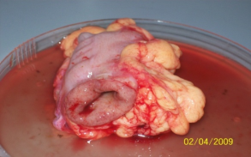Drug permeability in IBD tissues
Drug permeability of therapies intended for use in patients with IBD can be assessed in human fresh IBD tissues using our Ussing Chamber methodology. Where artificial permeability models often use Caco-2 cell lines, which don't reflect the normal expression of enzymes and transporters, we use human fresh gastrointestinal (GI) mucosa from IBD patients to determine drug bioavailability. If you are primarily interested in investigating ion channel function and drug metabolism across all patients, not only those with IBD, we can achieve this using GI tissues from healthy donors. Endpoints that can be measured in this translational model include:
- In vitro permeability of drug compounds (Papp)
- Phase I and II metabolism (e.g. CYP3A4 mediated metabolism of drugs)
- Short-circuit current (Isc), potential difference (PD), and transepithelial electrical resistance (TEER)

Image: A section of fresh intestinal tissue from a patient with IBD
This model uses intact gut mucosa from healthy donors to assess the bio-availability and permeability of your test articles.
This assay uses intact gut mucosa from healthy donors to assess the effects of your test article on ion-channel function.
This assay uses intact gut mucosa from healthy donors to investigate the effects of your test article on Phase1 and Phase 2 metabolic enzymes.